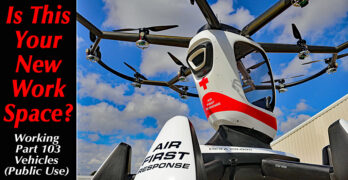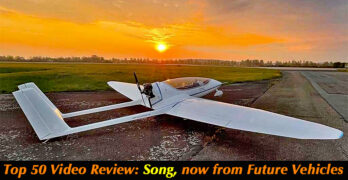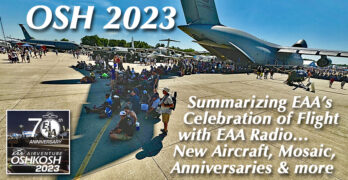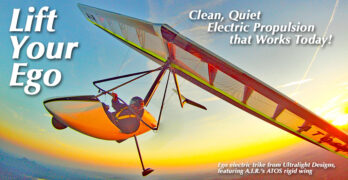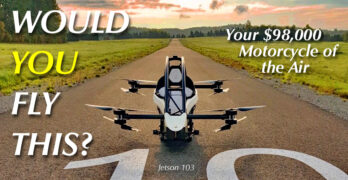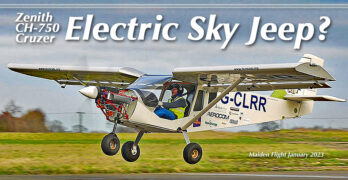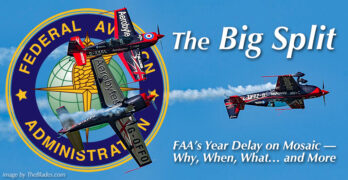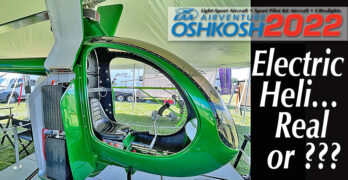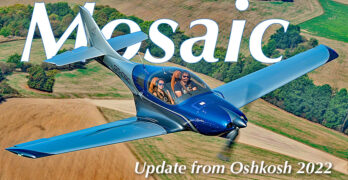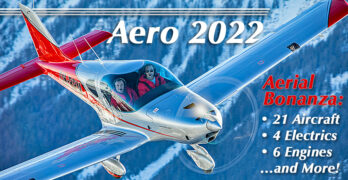As I recently wrote about Aerial Work for Mosaic LSA, perhaps it’s fitting to write about Part 103 vehicles doing commercial work.
But isn’t flying for hire prohibited in Part 103? Yes, it is.
However, “public use” aircraft do not have to meet FAA aircraft certification regulations nor operating limitations. “Public use” can include activities like police, fire, rescue, border patrol, and similar typically government functions whether provided by federal, state, or local agencies. In short, government departments at all levels get special privileges.
This means little to pilots unless you are one flying for a government agency. For the producers, however, this can mean potentially lucrative sales. In the case of Part 103 multicopter producers it may represent a means of market entry.
In this article I reference an aircraft covered before called Hexa (earlier article, with more aircraft detail), designed and built by Lift Aircraft in Austin, Texas.
Search Results for : multicopter
Not finding exactly what you expected? Try our advanced search option.
Select a manufacturer to go straight to all our content about that manufacturer.
Select an aircraft model to go straight to all our content about that model.
A Song to Lift Your Spirits — Clever, Sleek, and Part 103-Capable from Future Vehicles
You know this airplane and you know this company, although a refresher might be in order.
You can be excused if this one slips you mind. The airplane in the nearby images was from years ago when you probably first saw it with an electric motor developed by Randall Fishman, one of the original pioneers in the electric aircraft space.
He was so far ahead of his time that a market for electric had yet to develop. When Randall flew his first battery-electric-powered trike 16 years ago at Oshkosh 2007, no one was using the terms “air taxi” or “multicopter.”
Electric Aircraft Corporation didn’t complete many sales but Randall’s developments were ground-breaking.
Now the handsome Song returns with a new producer, Future Vehicles. Earlier I wrote about the charming biplane Dingo, a modern-day follow-on to Hovey’s Whing Ding and worthy entry in the Part 103 space.
AirVenture Oshkosh 2023 Is Done; Here’s an Overview Done On-Air with EAA Radio
It’s all over — EAA AirVenture Oshkosh, the world’s largest-attendance airshow event. It’s a delicious, if somewhat overwhelming, drink out of a firehose for an entire week.
Oshkosh has something for every pilot and more than any one person can see.
I’ll mention this news briefly as I wish to pay respect to fellow pilots. Two crashes on the weekend after we departed resulted in four fatalities reportedly including one passenger. My sincere condolences to the surviving families. Oshkosh has had safe years with no loss of life but when so many airplanes assemble, mathematical odds suggest a crash is going happen despite heroic efforts to make the event as safe as possible.
During the week of Oshkosh, a few days were rather warm. Cooling rains came mostly at night, sparing the airshow but surely soaking campers in tents. The campgrounds were full to the edges and EAA opened multiple other locations to handle the overflow.
Super-Efficient Electric Flight — Ego Trike with ATOS Wing Shows How E-Propulsion Works Today!
From dawn to dusk, we hear how electric propulsion is going to save the Earth. Whatever your belief about the hazards of fossil fuel, electric propulsion is coming. When is another matter.
Air taxi ventures based on multicopter designs are drinking up funds by the tens or hundreds millions of dollars, probably billions by now. I don’t have a shred of doubt that these will lead to genuine changes in transportation… but I would not hold my breath until such services become common. I suspect it will be many years yet.
However, today, electric propulsion for ultralight aircraft works quite well, especially when it serves a purpose. For soaring pilots, power is about getting to altitude where they can explore ridge, thermal, or wave lift. Those who love such flying, like me, seek out the best machine that might deliver that capability. Ultralight Design’s Ego trike can.
High-Tech Composite
Anyone who knows hang glider wings will admire both the construction and substantially higher performance of what’s called a rigid wing — more common hang gliders are called flex wings.
George Jetson Flying Machine — Now a Reality and a Qualifying Part 103 Ultralight?
Air taxis — eVTOLs — UAVs — UASs — UAMs. I like “multicopters,” but the name game continues.
Maybe these new-fangled flying contraptions have numerous (indecipherable) names because they’re still deciding which way they’re headed?
I believe aircraft like these are nearly inevitable and I not only don’t resist, I’m rather enthusiastic about them. I’d love to get picked up from my driveway and whisked by air to an appointment across town in minutes, free of clogged roads. C’mon, UberAir!
However, that dream may be years in the future. Oh, the technology is nearly ready now. It hasn’t been proven to be in-the-field robust yet but engineers know today most of what they need to make air taxis viable. Their much bigger challenge? Gaining public acceptance and winning regulatory approval. That could take a long time. Meanwhile…
What’s Here TODAY?!
Air taxis may be fuzzy in the distance but another class of these machines is nearly ready for market.
Should Your Out-Back, Off-Airport “Sky Jeep” Go Electric? Here’s One Answer…
Zenith’s headline read: “All-electric Zenith ‘Sky Jeep’ completes first flight, with plans to transport doctors and medical supplies in remote areas of the world.” Several aviation publishers jumped on the news* from light kit-built market leader, Zenith Aircraft.
I’m curious what you think of (1) electric propulsion on any aircraft and (2) electric power for an aircraft used, let’s say, for exploring. If you have an opinion and care to share it, use the comment feature.
To date, most electric-propulsion entries have been sleeker designs. Pipistrel has been a leader in this class; they got their start building sailplanes and motorgliders and never lost their preference for clean, smooth shapes. Many others also participated (nearby images).
Bye Aerospace’s eFlyer continues its long path toward the market. This development company based its aircraft on Arion’s Lightning airframe, a smart choice as Lightning is so smoothly constructed. This article describes what was then called Sun Flyer.
FAA’s Mosaic Rule — Delayed (a Year or More); Further Information about the New LSA Regulation
One of the most-read articles from my coverage of EAA AirVenture Oshkosh 2022 was the news that FAA missed their deadline as originally projected and will be a year or more late with the Mosaic rule. Many were upset at that result; others thought it was “par for the course.”
The good news, as I reported in the article, is that what emerges in one year will be a regulation that might actually go forward. Let me explain a little more fully.
During Oshkosh 2022, I attended three meetings where FAA spoke. I also had one-on-one discussions with several knowledgeable people. What follows is a fusion of all those conversations. While I believe this information to be accurate, the situation is changing and more questions will arise. Please consider this a snapshot in time.
The Main Question — As some commenters to the earlier article said, FAA did specify a date when the Mosaic NPRM may be released: “August 2023.” This came directly from David Boulter who was selected by the FAA Administrator to answer an audience question; the comment was made in a public forum.
Oshkosh 2022 – Day 2… Electric Helicopter from Composite FX is Lean, Green Machine
A year ago at Oshkosh, I became intrigued by the way Composite FX had developed the older Mosquito into their XE line; multiple models running from a legitimate Part 103 helicopter, their XEL model, to the turbine XET model. The company builds these handsome aircraft in Trenton, Florida after acquiring the design from Canadian John Uptigrove (see image of his original).
Vertical takeoff has a special appeal, even to those of us with little or no rotary experience. Setting aside the skills to fly such machines, the cost of a helicopter is usually so high that many don’t even consider it. Maybe they didn’t look far enough.
Composite FX and their $60,000 ready-to-fly XEL model (kit for $47,000) completely changes that thought experiment. Not only does this handsome aircraft perform impressively in experienced hands but many can afford it.
Yet this article is not about the product line the manufacturer is presently delivering.
Oshkosh 2022 – Day 1… FAA Mosaic Regulation Update; No NPRM Announcement; Changes Underway
Many of you have been asking about FAA and their Mosaic regulation. Let’s jump right into it.
Following is what I’ve learned even before the “Meet the Administrator” session that has become a staple of AirVenture thanks to excellent coordination by EAA’s professional advocacy staff.
That Administrator session is on Thursday. I will attend and perhaps learn more, but here is info direct from FAA contacts, speaking about actions that are already on the public record.
We will hear no Mosaic NPRM announcement at Oshkosh.
We may hear about work on the new regulation but the rule will not yet be published in the Federal Register as an NPRM or Notice of Proposed Rule Making.
As regular readers (or YouTube viewers) know, Mosaic is not being created solely for Light-Sport Aircraft. The coming rule encompasses warbirds, homebuilts, LSA, and Unmanned Air Systems (UAS). The latter includes all manner of electric and/or hybrid aircraft.
Aero 2022 Bonanza — Huge Aircraft Review from Europe’s Best Airshow
This year, 2022, saw a return to all the great airshows we have come to know and love. One of my all-time favorites and my #1 pick in Europe is Aero Friedrichshafen.
I already provided three articles — (1) turbines, (2) six innovations, and (3) Aero success — covering what I found to be highlights of Aero 2022 that I thought you would like best.
Now, thanks to encouragement from Marino Boric — a Europe-based, highly-knowledgeable professional journalist — I want to provide what longtime radio broadcaster Paul Harvey used to call “…the rest of the story.”
What follows is Marino’s few-paragraphs-each review of no less than 21 airplanes, 4 electric projects, and 6 combustion engines. You will not find this depth of reporting anywhere else in the USA.
Folks, this article is much longer than our usual articles (by 6X).


